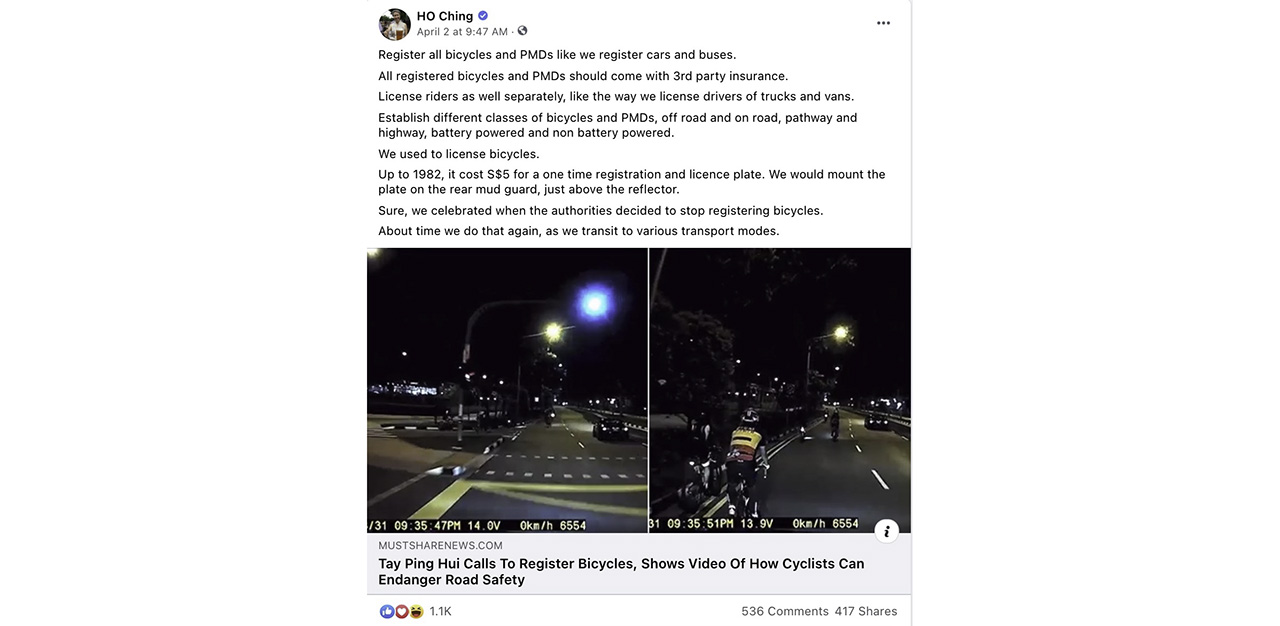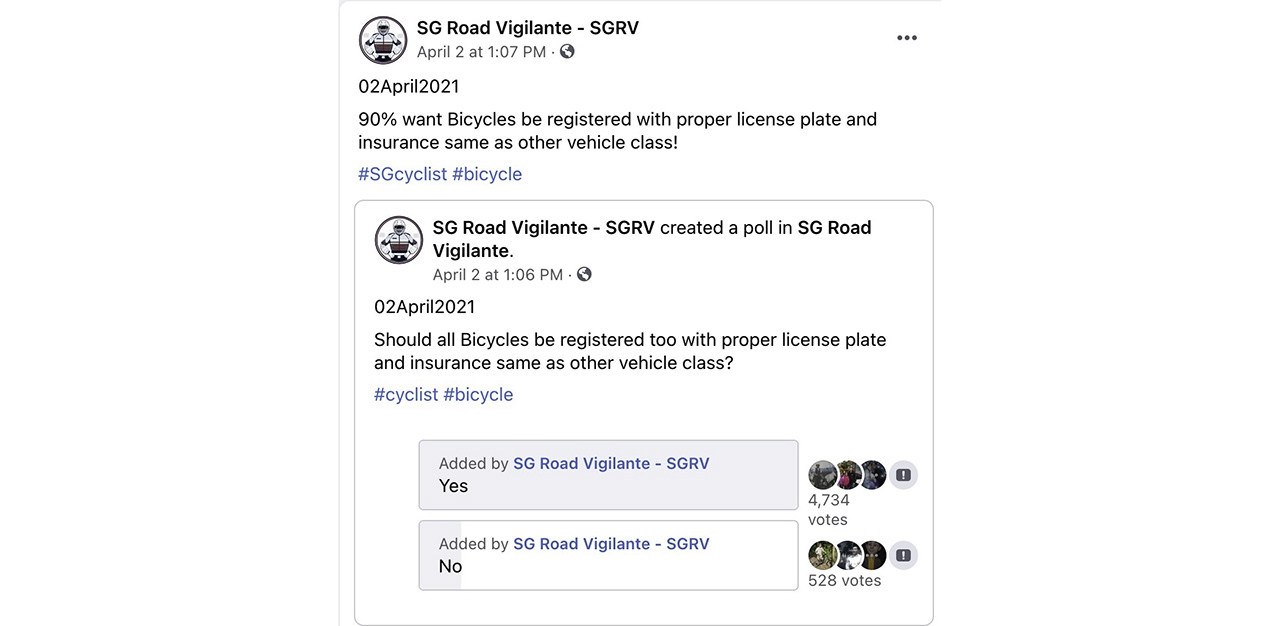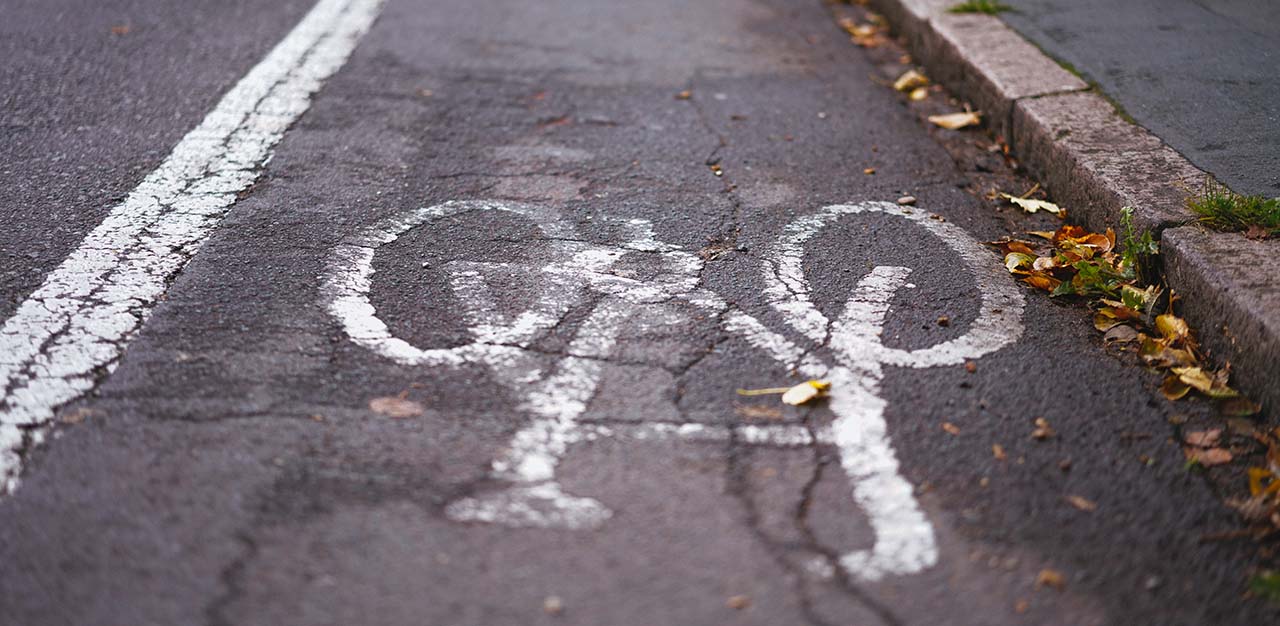In view of the recently rekindled debate over registering bicycles and licensing cyclists, TheHomeGround Asia weighs up the pros and cons of the potential scheme proposed by Singapore actor Tay Ping Hui and wife of Singapore Prime Minister, Ho Ching.
Anyone familiar with social media will know that it only takes a single post to set off a flood of heated exchanges among netizens. And a heated debate is exactly what ensued after Singaporean artiste Tay Ping Hui took to Facebook and Instagram on 1 April to vent his frustration over a run-in with a group of cyclists whilst driving, sharing a dashcam video of the incident. Mr Tay went on to advocate for all bicycles to be registered, arguing that many cyclists who break rules on the road do not care because “they know whatever happens, there’s no way to identify them” unlike other registered vehicles.
Writes Mr Tay, “A small visible license plate would allow the cyclists to be identified in cases of accidents, conflict or rule breaking. Such registration should be free, and insurance if any, should be minimal and not subjected to excessive profit making by the insurance companies.”
His suggestion did not fall on deaf ears. It was followed the next day (2 April) with a Facebook post from Ho Ching, wife of Singapore Prime Minister Lee Hsien Loong, who shared a media account of Mr Tay’s story on her feed. In her post, the CEO of Temasek Holdings calls not just for bicycles to be registered like cars and buses, but personal mobility devices (PMD) too, and that they should come with third party insurance.
Exhorts Mdm Ho, “License riders as well separately, like the way we license drivers of trucks and vans. Establish different classes of bicycles and PMDs, off road and on road, pathway and highway, battery powered and non-battery powered.”


Some 10 days later (12 April), none other than Chee Hong Tat, the Senior Minister of State for Transport, announces that an advisory panel will take several months to conduct a review of existing rules to see how to improve safety for both cyclists and motorists.
He explains that the Active Mobility Advisory Panel will examine the possibility of measures, such as the registration of bicycles, licensing of cyclists and whether theory tests should be required for riding on roads – similar to users of PMDs and electric bicycles. The panel will seek feedback from the public, while examining the pros and cons of licensing cyclists and studying the experiences of other countries.
Set up in 2015, the panel consists of representatives from relevant groups, such as seniors, youth, cyclists and motorists.
Licensing bicycles, a thing of the past
Until 1982, bicycles in Singapore were registered, a practice carried over from the colonial era. According to Mdm Ho, it cost S$5 for a one-time registration and licence plate. Since being discontinued, there have been regular calls by politicians and the public to revive the licensing of bicycles and riders. Former Nee Soon GRC Member of Parliament Lee Bee Wah even suggested in 2013 that cyclists take safety lessons as a requisite for getting a licence.
The Land Transport Authority (LTA) has not seemed keen to implement these ideas so far. In response to letters to a local newspaper forum in 2016, where readers had called for registration to deter rule-breaking riders, it said that a licensing system would be too resource-intensive. It also shared concerns that riders’ might be discouraged from the activity if licensing became mandatory.
“Many bicycles are sold and change hands every year. The profile of cyclists is diverse, ranging from very young children to the elderly. Some people cycle to work, while others cycle occasionally to neighbourhood amenities, or for leisure and exercise,” said LTA’s then-director of active mobility Tan Shin Gee. “It would be resource-intensive to implement and police a system to license bicycles or cyclists that is up to date.”
The battle over road space
The episode recounted by Tay Ping Hui is just the latest in a string of incidents pitting motorists against cyclists, with both sides quick to air their grievances about the other’s disregard for road safety rules.
In December 2020, for instance, a clip of a cyclist rear-ending a car near Yishun Dam went viral on social media. The man had taken his eyes off the road to gawk at a lorry accident, and as a result, crashed into the back of a Toyota sedan and shattered its windscreen. Netizens lambasted the ‘irresponsible’ cyclist.
Earlier this month, another video involving a car and a bicycle made its rounds on the internet after a mother and her young daughter were knocked down at a pedestrian crossing in Punggol, sparking a fierce argument in the comments section over who was to blame for the accident.
A scroll through community-run Facebook pages, like SG Road Vigilante, Roads.sg and Beh Chia Lor, turns up plenty of altercations between drivers and cyclists. This long-standing dispute may soon find a resolution, but the question is: ‘Would the proposed registration scheme prove a boon or a bane to cyclists?

Boosting road safety
Proponents of bicycle registration argue that it would improve road safety and act as a deterrent to cyclists who might be tempted to break or bend road traffic rules. Common complaints against cyclists include running red lights, hogging lanes by riding abreast, and zooming through pedestrian crossings without slowing down. Hence, the possibility of being held accountable for such behaviour could enhance safety for all road users, from cyclists themselves to motorists and pedestrians.
A registration scheme would enable the authorities as well as fellow road users to easily and efficiently identify errant cyclists via unique licence plate numbers, and would thus facilitate the process of reporting and penalising traffic offenders. The fear of getting caught and being brought to book could, in turn, discourage scofflaws from engaging in careless cycling.
A social media poll conducted by SG Road Vigilante following Mr Tay and Madam Ho’s posts revealed that 90 per cent of the 5,000-plus respondents favour registering bicycles with a licence plate and third-party insurance.
Some believe that licensing could resolve tensions since a major factor in the motorist versus cyclist conflict is that many drivers believe cyclists do not belong on the road. In short, it could clear up existing misperceptions over who has the right to use public roads

Cooling tensions between motorists and cyclists
Richard Toh, an avid cyclist who clocks around 1,000 kilometres every month, attributes this car-centric mindset to the significant increase in Singapore’s car population over the last few decades, in addition to the widespread misconception that cyclists have no claim to the roads because they do not pay road tax.
“If we revisit how and why roads were initially constructed, [we’ll see that] roads were [designed] for people, not for cars,” says Mr Toh. “That’s why roads are called public roads and are funded by general taxation, not by road tax. Every taxpayer [contributes to] the construction and maintenance of [public] roads.”

Cutting crime
Another benefit often given to register bicycles is that it would curb theft.
A national database of registered two-wheelers would not only work to dissuade thieves, it would also precipitate the return of any bikes that are stolen.
Case in point: When the Vancouver Police Department and the City of Vancouver in Canada launched a collaboration with a security software start-up in 2015, bicycle theft in the city dropped by 30 per cent in three years.
Although the Singapore Police Force (SPF) and the National Crime Prevention Council did introduce the Bicycle Security Label in 2011, participation in the programme has been voluntary. A mandatory registration scheme, on the other hand, might have better success in reducing the incidence of bicycle theft. Other deterrents to fight crime have included installing mirrors at public residential blocks, bicycle bays and rack areas. While the overall number of thefts has fallen over the years, in 2014, the police said that bicycle theft was one of the “major crime concerns”.
The cons of bicycle registration
Cycling enthusiast Wee Boon Kiat believes that a bicycle registration scheme is “simply a way to ‘stick a plaster on a gaping wound’, [but it] certainly does not solve the root cause of the problem”.
“If [Mdm Ho] thinks that registering bicycles would solve these problems [of poor cycling habits, road accidents etc.], then [by the same token] there would be no motor vehicle accidents in Singapore, since all our cars are registered,” adds Mr Wee. “In my opinion, registration is simply not the solution.”
Mr Toh concurs: “I am not against [a] bicycle registration scheme per se. But what I am against is that it does not [address] the root of the problem.”
But what exactly lies at the heart of the problem? According to experts, it boils down to a question of attitude. In particular, the adversarial attitude of motorists toward cyclists.
A joint study published in 2019 by Australian researchers from Monash University, Queensland University of Technology and University of Melbourne found that 55 per cent of non-cyclists rated cyclists as ‘not completely human’. The study also connects the dehumanisation of cyclists with acts of aggression against them. This includes drivers using their car to deliberately block or cut off a cyclist.
“When you don’t think someone is ‘fully’ human, it’s easier to justify hatred or aggression towards them. This can set up an escalating cycle of resentment,” explains lead author Alexa Delbosc. “If cyclists feel dehumanised by other road users, they may be more likely to act out against motorists, feeding into a self-fulfilling prophecy that further fuels dehumanisation against them.”
Therefore, unless there is a fundamental shift in attitude, legislation can only do so much.

Price of licensing
Cost is another obstacle for setting up a licensing system.
In 2016, LTA had explained in a letter to The Straits Times that while it had studied the licensing of bicycles and cyclists “very carefully”, it concluded that the disadvantages of doing so would outweigh the advantages.
“The main benefit of licensing is to aid identification and tracking of errant cyclists. However, this requires that the registry of licenses [sic] be regularly updated by licence holders. [But] there are practical difficulties for ensuring this is so,” said LTA’s Ms Tan.
In other cities around the world, from Toronto to Beijing to Seattle, laws pertaining to bicycle registration and/or licensing were abolished for the very reason that such systems were far too costly to operate. Even countries like the Netherlands and Denmark, which are known as cycling utopias and have the most bicycles per capita in the world, do not require bicycles to be registered or cyclists to be licensed. Instead, they focus on alternative strategies to encourage courteous cycling and uphold road safety.
Mr Wee also believes that a licensing regime would be antithetical to the Government’s ambitions to transform Singapore into a car-lite nation: “If implemented, a registration scheme would definitely discourage [people from] cycling,” he says. “Would the next step be for cyclists to pay road taxes and ERP [charges]? It is a slippery slope that should be avoided, [and] it would be a killjoy to active transport for sure.”
It’s plain unfair
Not every cyclist flouts the rules of the road, so making it mandatory for all bicycles to be registered and all cyclists to be licensed runs the risk of seeming unfair.
“Just as there are inconsiderate cyclists, there are also inconsiderate motorists who purposely drive [too] close to cyclists,” says Mr Wee. “There are also inconsiderate pedestrians who do not keep [to the] left [on shared paths], groups who do not walk in a single file, and ‘handphone zombies’ who do not look where they are going. Cyclists should not be the only group to be penalised.”
Adds Mr Toh, “We don’t want a situation where we penalise the majority for the behaviour of the [errant] few. But I suspect this is exactly what a bicycle registration scheme would end up doing.”
Instead, he insists that data collection is necessary to understand the matter and to “substantiate” how many cyclists have “endangered other road users” because of their “errant behaviour”.
“Because I’m active in the cycling community, and I’ve done a fair bit of research based on road traffic statistics, when a cyclist beats a red light – a cyclist on a 12kg bicycle travelling at 30kmph – he’s not going to cause a lot of harm [to other road users]. If a cyclist hits a car, it’s the cyclist himself who would probably end up injured, not anyone else.”
He continues, “As far as insurance is concerned, we have the statistics to show that motorists [can] inflict a great deal of harm [on others], and we have the statistics to show the frequency of accidents [involving motorists].
“From the point of view of economics and of the need to protect public safety, [we can] arrive at a sound conclusion that [third-party insurance for motorists] should be mandatory. [But] do we have the conclusive evidence that demonstrates that cyclists [can] wreak so much damage that you would require them to carry third-party insurance before you allow them on the road?”
Government’s response to rekindled debate
Over the coming months, Active Mobility Advisory Panel will conduct its review to ascertain whether a revision of extant regulations is necessary, and to determine the feasibility of registering bicycles and licensing cyclists.
It will also raise awareness of existing traffic rules, working in tandem with stepped-up enforcement by LTA and SPF to boost road safety.
Mr Tat emphasises that it is important “not to rush the process, but to hear from all the different stakeholder groups before [the Government] come[s] up with a set of recommendations.”

Other possible courses of action
In order to bring about a lasting attitudinal change and foster a more gracious society, education is key, rather than just a focus on enforcement and creating awareness.
Mr Toh suggests a two-pronged approach. The first, revamping drivers’ education.
“I’ve cycled near a driving centre in Woodlands, and [on several occasions] I’ve [met] learner drivers who were told by their instructors to drive so close to me as to endanger me,” says Mr Toh. “Now, if a driving instructor isn’t teaching someone who’s learning how to drive the right thing [to do], then what kind of motorists are we putting on the road? I think that [starting] right at the driving school, change has to happen.”
The second, reiterating that all road users must share road space in a safe manner.
Mr Toh stresses that drivers “grasp the fact” that roads are not only meant for their exclusive use: “I’m under no illusion that it’s going to happen overnight, but the Government needs to undertake some sort of [education programme] to keep driving this message home – that roads are [meant] for people, and not [solely] for motorised vehicles.”
Building an infrastructure that considers multiple modes of transport
If a shift of attitude is the requisite software for addressing the root of the problem, then the requisite hardware is intelligent transport infrastructure. While the Government has plans to expand the island’s cycling path network to 1,300km by 2030, some people think these infrastructure upgrades are still insufficient to meet the needs of the growing population of cyclists here.
A Redditor and food delivery rider who goes by the username “wazookazooman”, shares his thoughts on the topic: “Footpaths are impossible to ride on because of the 10[km/h] law and [the] ban [on PMDs] on riding on neighbourhood footpaths. PCNs [park connector network] are very hard to ride on because of the sheer number of people and those [who] do not keep to their side of the pathway. So, many cyclists [and food delivery] riders [have to travel on the road] if they want to make it to places on time.”
Mr Wee agrees. “In many other countries, bicycle lanes [take up a segment of] the road. But in Singapore, the only bike lane on the road I know [of] is at Tanah Merah,” he says. “If the Government is serious about fostering a harmonious relationship between cyclists and motorists, then we need more of such bike lanes.”
READ: Switch to walk-cycle-ride modes step in right direction
Join the conversations on THG’s Facebook and Instagram, and get the latest updates via Telegram.














